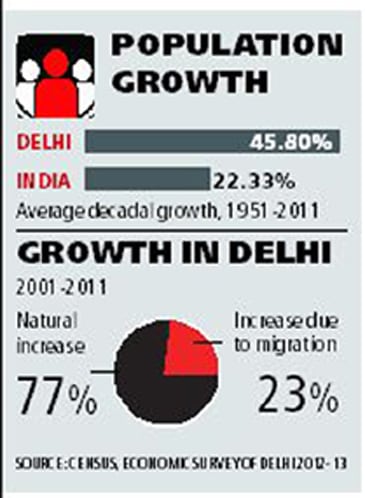A City with Room for Migrants, if Not a Roof Over Their Heads
Swaniti Initiative | February 3, 2015 | The Swaniti Blog
Date of Release: February 3rd, 2015
Published in: Indian Express
In electoral arithmetic, nothing plays as big a role as the demographic profile of a city or state. In Delhi’s case, migration is believed to be a major determinant in an evolving demography. This also has a direct bearing on Delhi’s housing situation, an issue that has remained central to the political promises of all three major parties.
ARRIVAL & GROWTH: Since 1951, the average decadal growth in Delhi’s population has been 45.8 per cent, exceeding 45 per cent in every decade except 2001-2011, when it increased by 21 per cent. This was far higher than the national average decadal growth rate.
More crucially, migration accounts for more than 23 per cent of the total increase in population. This is calculated as the additional increase in mid-year populations in each year between 2001 and 2011, over and above the natural increase (difference between birth and death rates). In the absence of migration, Delhi’s decadal growth rate during 2001-11 would have been lower than the national average of 17.64 per cent.

According to the last available granular numbers (Census 2001), Uttar Pradesh accounted for almost half (43.1 per cent) of Delhi’s migrants. This has increased to 47 per cent, as per a recent Perceptions Survey (2013) conducted by the Institute for Human Development for the Delhi government. Bihar’s share has also risen to 31 per cent from 14 in 2001. Clearly, Delhi has transformed steadily from being a Punjabi migrants’ city to being a melting pot for people from the Hindi heartland.
This has altered the socio-economic profile of the city. According to a 2013 study (Changing Electoral Politics in Delhi: from Caste to Class) 63 per cent of migrants in Delhi from Bihar and 46 per cent from UP are “poor”. In other words, while overall wealth might be increasing, so are inequalities. Secondly, 45 per cent (according to the Delhi Statistical Handbook, 2014) of migrants are women, most of whom migrate after marriage. As noted earlier in this series, a large number of these women remain vulnerable and insecure due to lack of employment opportunities. These social and economic factors will certainly play a vital part in political calculations leading to the polls.
HOMES & HOMELESS: Perhaps most critically, rapid migration has also adversely affected housing security in Delhi. In 2011, Delhi’s share in the urban houseless population was more than 5.1 per cent, even while Delhi accounted for only 4.2 per cent of the total urban population. The absolute number of houseless people also doubled between 2001 and 2011. This was much higher than the national increase in urban houseless at 20.5 per cent.